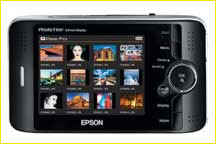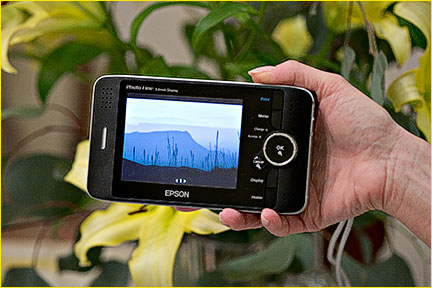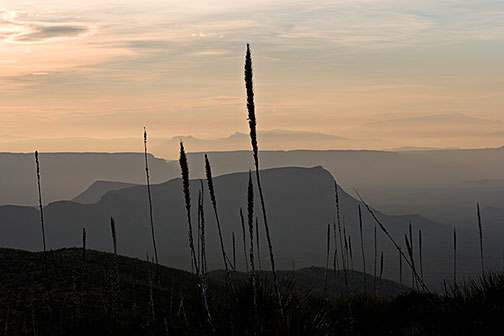
I first saw a prototype of what was to become theEpson P-2000, at a trade show about 18 months ago. It looked interesting, but when the Epson rep told me that it used USB 1.1, I shook my head in dismay, and walked away. Apparently Epson’s marketing people felt the same way, as the product never shipped, only to resurface again at Photokina in September, 2004. This time it has USB 2.0, as well as a number of other enhancements. As of late November, 2004 it has started shipping to consumers.
This is the portable card transfer / hard disk (digital wallet type device) done right. Until now there have been several attempts at such units by smaller companies, but all have been flawed in some way. The three main areas in which they have been weak have been with regard to battery life, screen size, and disk size.
Most of these units have had undersized batteries, and one would be lucky to be able to copy two cards before the battery would die. Screens were small and dim, and there was rarely the ability to read Raw files. Also, until recently, hard disk sizes were’t that generous.
Now, with the Epson P-2000, most every one of these issues has been addressed. As will be seen below, the P-2000 is capable of copying thirteen 1GB cards on a single battery charge, and a spare lithium ion battery can be popped in in moments. The 3.8" LCD screen offers stunning image quality, and the device is capable of reading a number of contemporary raw file formats as well as JPGs. Finally, the device contains a 40GB hard disk (36.5 GB available for storage).

Form Factor & Controls
The P-2000 is larger than a pack of cards, but smaller than a paperback book. It sits comfortably in the palm of ones hand, and lives snugly in a supplied nylon belt pouch. It has two card slots on the top edge, one for CompactFlash cards and the other for SD cards. The CF slot accepts Type 1 and Type 2 devices, including Microdrives.
The almost 4" screen is remarkable. It is bright and sharp, and quite viable in daylight as well. Epson describes it as aTransparent poly-silicon TFT LCD, but whatever it’s called, it’s beautiful. It displays 640X480 resolution, though frankly, it appears to be more.
The power switch is a spring-loaded slider on the right hand size, and there is a "Hold" position. On the left side there an AV style minijack that carries stereo audio as well as video. An AV cable is not supplied with the unit, but these can be picked up anywhere. This allows you to connect the P-2000 to the composite video and audio jacks on any monitor or TV.
There is a standard mini-headphone jacks, a jack for battery charging and running on AC, and a mini-USB 2.0 connector. The USB connector is protected by a captive plastic cover, though the other ports are not.
The front panel has a largeOKbutton surrounded by four navigation controls – sort of a mini joystick. There is aCancelbutton beside it, and then four other recessed buttons;Print, Menu, DisplayandHome.
Printallows you to print from the P-2000 directly to a supported printer. The others are pretty much self explanatory as well, withDisplayacting as a sort of Help screen.
The case is mostly plastic, but there is a metal frame around the periphery which provides rigidity, and some measure of protection. The screen appears to have a very tough and scratch resistant plastic cover.
It is worth a comment that the menus of the P-2000 are simple, attractively designed, and intuitive. A minimum of button presses is required to accomplish most tasks. To copy and store a card, for example, simply turn the unit on, insert a card, point to theCardIcon, and selectCopy Card. It couldn’t be simpler or more intuitive. When done, the display tells you that it’s safe to remove the card, and then displays thumbnails of each frame.
There is a soft blue light bar to the left of the LCD that pulsates whenever there is disk I/O going on, whether copying a card, or when connected to a PC, so that even of the screen has timed out and gone dim, you know what’s going on.
Mercifully, the AC adaptor / charger is quite small. But for some reason Epson doesn’t provide a case for it, so you’ll have to drop intoBest Buyand pick one up. Make sure that it’s big enough to also hold the provided USB transfer cable as well.
Viewing
The P-2000 will display JPGs, and allow you to enlarge them onscreen. A number of Raw file formats are also supported, but enlarging of Raw files is not possible. One very nice touch is that if you press theDisplaybutton when a file is on-screen a transparent overlay of EXIF data is also shown, including almost all the shooting data, such as camera, lens, exposure, etc. Nice!
As of first release in November, 2004, the Raw files supported include .NEF, .CRW, .ERF, and .CR2. Personally, I was pleased to note that the new Canon 20D and 1Ds Mark II files were supported as well, though not mentioned in the documentation. The cameras that are mentioned include the Epson R-D1 (of course), the Nikon D100, D1H, D2H, D1X and D70. Canon cameras include the D30, D60, 10D, Rebel and 1D Mark II. Owners of cameras other than these can still use the device, but will not be able to review their Raw files; JPGs only may be viewed. I would urge Fuji, Olympus, Minolta and other camera owners to lobby Epson for support.
The on-CD manual mentions that firmware updates will be available from time to time fromhttp://support.epson.com. If Epson releases these in a timely manner, to keep up with the flow of new cameras, they will ensure that the P-2000 has a long life and loyal following. Indeed, considering this unit’s price, features and versatility, if they expand Raw support to all the major camera makers, Epson could own this market. My device has firmware Ver.01.01.
As an example of the P-2000’s thoughtful design, there is an icon on the main screen called Latest Data. It will display the contents of the last card copied to the unit. If a lot of cards are being transfered this makes having a look at the last set of files quick and simple.
Transferring to the Computer
The device attaches to your computer, Mac or PC, with a USB 2.0 cable (provided). It then appears as a hard disk, and the usual file copying procedures can be used to move files to another hard disk. There isn’t much more to say, other than this can not be done on battery power alone. The AC adaptor needs to be used.
Update:It turns out that you can do transfers on battery alone. The drive mounts, and though the warning about using AC power stays on the P-2000’s screen, it will work fine on battery alone.
Transferring a directory that contains 1GB worth of data from the P-2000 to a PC or Mac takes about 90 seconds.
More
In addition to being a digital wallet type device, the P-2000 is a capable MP3 audio and movie player. It supports MP3 and AAC formats for audio, and Motion JPG and MPEG-4 for video. I did no serious testing of either of these modes, but if you ever visit a store than has a P-2000 on display, ask to see the demo movie. It’ll knock you out! Videographers rejoice.
Performance
Copying a 1GB card to my Mac Powerbook via a Firewire card reader takes almost exactly 4 minutes. Copying that same card to the P-2000 required almost 7 minutes. This compares to about 13 minutes using a standard CF card reader in the computer’s PC Card slot.
One of the problems with portable card storage devices till now has been battery life. Copy one or two cards, and the battery is dead. The P-2000 breaks that mold. I copied a 1GB card to the Epson, waited 20 minutes, and then copied it again. This simulates a typical worst-case field use situation where cards are being filled quickly, and it also gives the battery a reasonable time to "recover" between copies.
I was able to copythirteen1GB cards to the P2000 before the low battery warning light came on. At this point, though the device continued to function for quite a while, it warned that there might not be enough juice to complete a copy. Very intelligent.
This is superb performance, especially considering that I had the power settings such that the LCD was illuminated the whole time, and I also did a moderate amount of file browsing inbetween card copying sessions.
This tells me that a single battery is likely to be more than enough for even the busiest photographer’s day in the field, and if on-screen review is used sparingly one could go on a week-long hiking trip and still not run out of juice, or disk capacity. And, if that was a concern, a second battery would be all that’s needed to carry you through.
Albums and Slide Shows
The P-2000 allows creating namedAlbumsfrom individual images or groups of images. These files are copied to a new directory when you do this, so it’s a good way of organizing your shots in the field rather than just having them in the copied card directory. Because the LCD screen is so big, sharp and bright, you can actually use it to judge image quality, something that isn’t possible with any camera LCD that I’ve ever seen.
You can also organize groups of files in an album into a slide show. You can program transition effects, delay time, and even background music. Unfortunately, this only works with JPGs, not Raw files.

Big Bend Sunset – Texas, November, 2004
Canon 1Ds MKII. 70-200mm f/2.8L @ ISO 100
In the Field
I gave up in this type of device a couple of years ago because I found their battery life and screen issues weren’t worth dealing with. Instead I got in the habit of traveling with a notebook computer and a lot of cards. I’d work all day on location and then in the evening, at the motel, hotel, or campsite, I’d copy the cards to my computer.
This has a couple of downsides. Firstly, on a busy shoot it means needing and handling a lot of cards. This means keeping them organized, knowing what’s on what, and not mixing shot with unshot cards. The number of times either I, or people I’ve been shooting with have had a panic moment looking for a missing card that weknewwas in a certain pocket, are too frequent to mention.
Now, my procedure is as follows. After a card is full, I immediately copy it to the P-2000. This can be done while I continue to work, because the unit is in its pouch on my belt while it’s doing its thing. If I have lots of cards with me, or I’m not shooting a lot, I simply delay erasing and reusing the cards until the evening, for additional safety. If I need to though I can erase the cards as soon as they’re copied to the P-2000, and after I’ve verified that the shots are safely there.
When I get back to my computer later in the day, I copy all of the files from the P-2000 to the computer. Normally I would then copy these to an external hard drive, like a Lacie 60GB, but now the files are already in two places, so this isn’t necessary.
The reason that I always want my files in two places is, security. When I’m away from the hotel or motel I leave the laptop there (locked with a security cable), but I travel with the P-2000 on my belt or in my camera bag. When I fly home, the P-2000 sits in my jacket pocket, while the laptop is in its bag in the overhead compartment. The chance of a hard disk crash, or theft, or other form of loss, is thus reduced to as close to zero as reasonable precautions allow.
Annoyances
On the P-2000 Compactflash cards are inserted with the label facing away from you. This is opposite to the way almost every camera or card reader works, and is an inexplicable design decision on Epson’s part. If you insert the card the wrong way (which is all too easy) you may have a devil of a time removing it. I did the first time, and it required a pair of needle nosed pliers to remove. No damage to either the Epson or the card, fortunately, but I urge Epson to correct this.
Some Epson literature indicates that the SD card slot is limited to cards of 512MB or smaller. But, the provided CD-based manual says that this only applies to older MMC cards. If it does apply to current SD cards this seems to be an arbitrary limitation, and with 1GB SD cards becoming available, and needed with cameras such as the Canon 1Ds MKII, this might be an issue if true.
The default mode of the P-2000 is not to display images that it doesn’t recognize. It is easy enough to go intoView Modeand then selectUnsupported Files, and then selectShow. But, this should be the default condition, and many users are going to quietly freak when they first find that their precious files don’t appear to be on the device.
When copying files from the P2000 to a computer the unit must be plugged into AC power. This is understandable, since Epson wants to ensure that the unit does not run out of battery power during a transfer, and thus corrupt files. But, rather than being absolutely prevented, it should just be a warning. There are a great many times and places were a field transfer of files, away from AC power, is necessary. We’re grown-ups, Epson. Don’t baby us too much.
Update:It turns out that you can do transfers on battery alone. The drive mounts, and though the warning about using AC power stays on the P-2000’s screen, it will work fine on battery alone.
Finally, when directories of downloaded files are copied to a computer, and then deleted from the P-2000 via your computer, the empty directories are still found on the Epson’s display screen when you view the Downloads window. These directories are empty, of course, but they aren’t removed. The only way to get rid of them is to delete them using the P-2000’s navigation window.
Price
In the U.S. the Epson P-2000 has a retail price of $499.99. It can be purchased from retailers (possibly at a discount), ordirectly from Epsononline. By way of comparison, aLacie 60GB Firewire Drive(which of course needs to be attached to a computer), lists at $349. Now I know that I’m comparing apples and oranges, but these devices are roughly the same size. Even just used as a portable hard disk, the P-2000 isn’t much more expensive, and when you add the fact that it’s also a dual format card reader, MP3 player, and video player, the extra $100, and lower storage capacity, don’t seem all that much of a compromise.
About Deleting Card Directories
The proper way to delete unwanted card directories is by using the delete function within the P-2000. If you do so via your computer, the directories will not be properly removed. Also, if you’re a Mac user, be aware that when you delete files and entire directories from an external drive such as this, they are really not deleted. They are stored in an invisible directory on the drive called.Trashes. Therefore, while the files appear to have been deleted, the space on the drive is not freed up, and you could find yourself with a P-2000 that has no files visible, but also no space available.
Just remember to empty the trash on your Mac while the P2000 is attached, so that the space is released. Or better yet, do all discarding and clean up from within the P-2000.
Recommendation
It doesn’t quite get a 10, but it’s damn close. Apart from a few niggles detailed above, this is to my mind the best device for copying, transferring, reviewing and storing your files in the field that I’ve yet seen. Even if you’re just going out shooting for the day, throw a P-2000 in your camera bag or on your belt. You soon won’t know what you ever did before you had it.
Three thumbs up!
You May Also Enjoy...
Cusco_panorama
Navel of the World©Miles HeckerCLICK ABOVE IMAGE TO SEE GOOGLE MAP LOCATION SEASONS In the Quechua, the language of the native people of the Andes,
